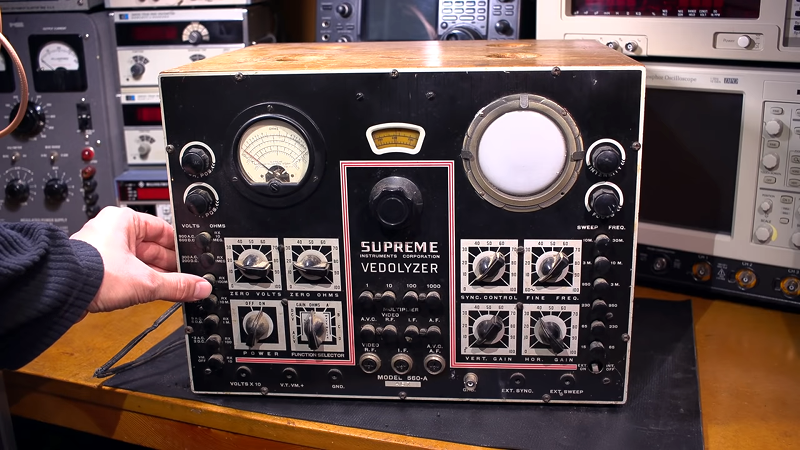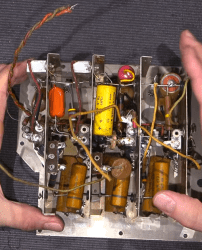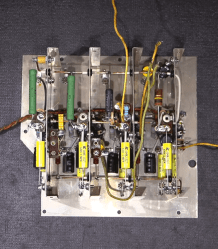There’s an old joke that all you need to fix TVs is a cheater, a heater, and a meter. If you don’t remember, a cheater was a cord to override the interlock on TVs so you could turn them on with the back removed. Of course, in real life, pro repair techs always had better equipment. In 1939 that might have meant the Supreme Vedolyzer which combined a meter, a ‘scope, and a wavemeter all in one device. [Mr Carlson] acquired one that was in fair shape and made a few videos (see below) of the teardown and restoration.
[Mr Carlson] wasn’t restoring this as an art project, by the way. He plans on using it, so he was less concerned with authenticity and more worried about usability. That led him to do things like remove the input jacks and replace them with BNCs. The video series is a bit of a time investment. Part one is about 82 minutes long! But if you are interested in old gear, this is a chance to peer inside an unusual specimen.
If you don’t watch anything else, though, you should have a look at the rebuilt center tube assembly. There were quite a few old components in that module and some had already been replaced by someone else. The before picture (left) and the after picture (right) shows off [Carlson’s] skills nicely.
You might wonder why he might want to use a piece of antique gear like this when he obviously has state-of-the-art equipment at his disposal. We get it. Just as you see people making soap or lace using old fashioned methods, it has to be satisfying on some level to use old test gear to restore old radios.
Supreme, by the way, was an instrument company from Greenwood, Mississippi. They made a lot of gear including an audolyzer (aimed at radio servicing). That web site, by the way, has scans of the user’s manual and other documents related to the instrument.
In 1939 engineers probably were not servicing a lot of TVs — RCA introduced American TV that same year at the World’s Fair — so this might have been a risky investment for most service centers. The history of TV around that time is pretty interesting. Our favorite pro TV service tool, though, was the later TV Analyst. This was a little TV station that could send an errant TV any signal you needed to isolate the problem.

















I love Mr Carlson’s Lab!
I don’t know how he keeps all that equipment so clean and STILL has time to actually use it. I am lacking in both areas!
for those interested in vintage testgear and teardowns my budy Max runs a channel that revolves around his shop full of vintage electronics https://www.youtube.com/user/maxkoschuh
I have to admit that he takes “thorough” to such a high level that I don’t have patience (or time lol) to watch his videos. They are works of art, each, and I respect the amount of time and effort he puts into explaining things.
I’m older than the equipment he fools with. I’ve watched a few, and after a while decided that nostalgia ain’t what it used to be.
His videos are perfect to put on in the baclground while working on your own stuff.
I watch his videos while tinkering and it keeps me ‘in the zone’ while I mess with my own stuff.
same, unless its a particular piece of gear im interested in more than a passing way.
In the past I servives TVs, and other consumer electrics part time to keep my vo-tech education sharp. These day I really don’t know where to begin to trouble shoot a TV beyond insuring the power supply is doing what i’s supposed to do
Repairing TVs and monitors now days is easier than ever, step 1 determine if it is worth fixing, step 2, if it is worth fixing, replace the one oddball blown capacitor in the power supply. About 95% I repair are just that.
One of the best channels for electronics repair.
Many beers ago I picked up a Sencore VA62 ( I suppose it’s their 62nd Video Analyst) for cheap at a hamfest. It can do just about everything to t-shoot an analog TV or VCR. Sadly, (thanks FCC, or whoever), no one wants there analog TV’s fixed anymore, and I’m not gonna fix them and have to give them away for next for nothing. It sits proudly on the workbench, and impresses customers, that at least I know what I’m doing trying to fix their flatscreen, etc. Sencore wanted an arm and leg for the manual, but thankfully I just downloaded the completed set from archive.org . It’s profitable for fixing arcade monitors, ringing Xfrms, it can do 100 things !
In a previous life I submitted my resume’ to Sencore.
“You might wonder why he might want to use a piece of antique gear like this when he obviously has state-of-the-art equipment at his disposal.”
State of the art equipment doesn’t fall into my budget so this might just be inexperience talking here but do you really want to plug some multi-kilodollar digital beauty of a scope into some crusty old piece of tube equipment that runs off of an unregulated high-voltage supply? That idea makes me nervous! Using similar-era test equipment sounds a lot safer to me.
Also, I’m thinking of some old Heathkit gear I have had now. If you have a manual with alignment procedures that manual will refer to the equipment of the era. If you want to actually follow the manual rather than just wing it you are going to need that equipment. Maybe for more experienced people “just winging it” isn’t such a problem though. I don’t know… yet.
OK years as a radio communications tech, Ham radio op for 60 years and I am having trouble figuring out the wave meter circuit. The tank appears to be a parallel tuned circuit across the signal line. Why doesn’t it null the signal instead of peaking it? I may be looking at the schematic wrong. I’ve been away for a while and it’s a little confusing. The plate of the first amp has two 2-12 var caps in series to the 2nd amp and another var cap to ground from thr caps split which I think might be the tuning cap . The reason I;m interested is I have a desire to have one of these and since they are UN-obtainium I may just roll my own for function at least. Looks like I could steal the guts from a Supreme signal gen for the rf section?
I have done some calculations that suggest, based on the output of his YouTube content and maintenance of his labs, there must be at least 3 Mr. Carlsons meaning he has also been successful in cloning.